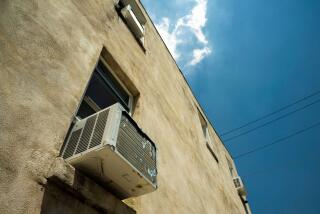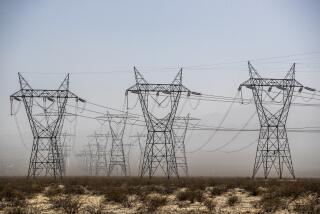N.Y. Set to Skate Through Summer
- Share via
NEW YORK — Mindful of California’s woes--and past blackouts that plunged the Big Apple into chaos--New York energy officials voiced cautious optimism Thursday that the city would have enough power to get through the summer months and avoid a dramatic increase in rates.
But they warned that the picture could worsen in future years if the state fails to construct a series of new power generators to keep up with rising consumer demand. Without added capacity, “our situation really does not look too hopeful,” said William Museler, president and CEO of the New York Independent System Operator, the nonprofit agency that operates the state’s wholesale electricity markets and manages the power grid.
“There needs to be a sense of urgency,” he said at a news briefing, explaining that without new plants “the rates will go up and the reliability of the system will become suspect. In a city like New York, that’s unacceptable.”
The proposed new plants, however, have drawn fire from environmental and community groups throughout New York, who fear they will aggravate pollution and slow badly needed efforts to conserve power. The energy blueprint issued Thursday “is simply a build-build mentality, which ignores the fact that increasing efficiency is a much better way to meet energy needs,” said Ann Reynolds, a clean air activist with the Albany, N.Y.-based Environmental Advocates group.
New York’s energy dilemma--underscored by consumer rates that are well above the national average--has generated fierce political debate. Democrats have accused Republican Gov. George Pataki of having mismanaged energy deregulation in the mid-1990s; Pataki responds that few officials could have predicted the rapid change in energy markets, and he has called for the construction of more power plants.
Yet for all the conflict, few experts believe New York faces a California-style meltdown.
Indeed, power companies in the New York metropolitan area can automatically pass energy cost increases to consumers, unlike California utilities, some of which have gone bankrupt because of their inability to do so. Moreover, New York state imports only 3% of its power from outlying areas. California buys 25% of its power from other states and has been increasingly at the mercy of fluctuating prices and availability.
The differences are telling but not necessarily reassuring.
Many New Yorkers remember the trauma of previous blackouts. A 1965 power outage plunged the city into darkness and trapped more than 800,000 people in subways and high-rise buildings for several hours. A 1977 blackout led to looting and violence, more than 3,000 arrests and $300 million in property damage. Two years ago, the Washington Heights section of northern Manhattan lost power during a heat wave after an electrical power cable caught fire. More than 200,000 people were affected.
While no one could have predicted the freak accidents that caused these outages, state officials said they have taken steps to head off similar blackouts this summer. And a key safeguard, Museler noted, has been the recent proposal to operate seven temporary stations--small electric generators--that would produce an estimated 400 megawatts of power.
The plants, to be operated by the New York Power Authority, will be up and running this month in Queens, Brooklyn, Manhattan and the Bronx. State officials said it was crucial to put these new facilities on a fast track. But as Reynolds sees it, they were “rammed through” the review process and exempted from lengthy scrutiny because they are smaller facilities. While many community groups have vowed to halt the generators, she added, two legal appeals so far have failed to stop them from operating.
Overall, the city will need 8,428 megawatts to get through the May-September period. And the new electrical generators--combined with New York’s existing capacity--will produce just enough power to help New York meet the demand, Museler noted. He also was encouraged that weather forecasters have predicted a hot summer but no “extreme weather” that could lead to dramatically increased power demands and trigger a systemwide failure.
Some city officials, including Mayor Rudolph W. Giuliani, have praised the state’s push for these temporary generators. “This has ramifications beyond the economy,” Giuliani told real estate and electric utility executives in a March speech. Warning about New Yorkers’ ever-present fear of blackouts, he said the controversy “goes to whether people are going to live or die. Whether people are going to be safe.”
State power officials also have endorsed a plan to permit large institutions such as colleges, hospitals and factories to operate their own diesel generators when a power outage seems imminent. Currently, such generators only may be used after a blackout. Officials believe this rule change would reduce pressure on the state’s energy grid in an emergency.
But some fear that New York’s determination to avoid summer blackouts at any cost eventually may open the door to widespread environmental abuses.
“This is an incomprehensible idea,” said Peter Iwanowicz, environmental health director of the American Lung Assn. of New York State, referring to the diesel generator proposal. “Even with the best control technology, your average diesel generator is dirtier than an uncontrolled coal-fired power plant. All of this could create a huge public health problem in New York.”
More to Read
Inside the business of entertainment
The Wide Shot brings you news, analysis and insights on everything from streaming wars to production — and what it all means for the future.
You may occasionally receive promotional content from the Los Angeles Times.










